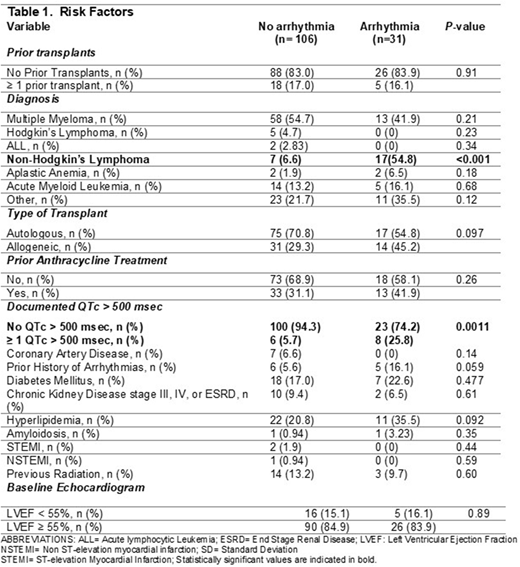Abstract
Background: Approximately 9% to 27% of patients undergoing hematopoietic stem cell transplantation (HSCT) develop a cardiac arrhythmia (CA).[1] This complication correlates with longer length of stays, higher probability of ICU admission, and higher mortality compared to patients who do not develop CA. Moreover, post-transplant CA is associated with greater risk of death within a year of HSCT.
Identification of predictive risk factors for CA in patients undergoing HSCT has been elusive. Traditional risk factors like male gender, smoking, hypertension, diabetes, hypercholesterolemia, or established coronary artery disease, have not been found to be predictive of pre or post-transplant CA in HSCT patients. Echocardiogram may help identifying patients at risk of post-surgical arrhythmias but this has not been the case in HSCT.[2] MUGA scan has not been able to identify patients at risk for developing cardiac events during HSCT either.[3] In view of the detrimental consequences associated with CA during HSCT and the lack of reliable predictive risk factors, we decided to analyze and identify potential risk factors for CA in patients transplanted at our institution.
Objective: This study aims to determine risk factors for the development of CA in patients undergoing HSCT.
Methodology: A retrospective analysis of 138 consecutive patients undergoing HSCT at our institution between January 1st, 2015 and December 31st, 2017 was performed. One patient was excluded due to lack of baseline EKG. Data from patients ≥ 18 y/o who underwent autologous or allogeneic HSCT was analyzed. Variables analyzed included: age, gender, ethnicity, prior HSCT, diagnosis, type of transplant (autologous vs allogeneic), prior anthracycline exposure, diabetes mellitus, chronic kidney disease, hypertension, coronary artery disease, congestive heart failure, hyperlipidemia, previous arrhythmias, amyloidosis, documented STEMI or NSTEMI, home medications continued during HSCT, prior cardiovascular procedures, left ventricular ejection fraction prior to HSCT, baseline QTc prior to HSCT, stem cell dose, conditioning regimen, graft-versus-host disease prophylaxis, number of prior acute kidney injuries using RIFLE criteria, documented infections, electrolyte abnormalities, and hemoglobin < 7.0 g/dL.
Statistical Methods: The Statistical Analysis Software (SAS) System program V9.0 was used for analysis. To compare potential risk factors of categorized data by patients with a documented arrhythmia and patients without a documented arrhythmia, a univariate comparison was performed using chi-square or Fisher's Exact test. Variables that were collected and demonstrated, as per-patient means, were analyzed using a multivariable T Test linear regression. A difference in incidence of arrhythmias between variables with a P-value of < 0.05 were statistically significant.
Results: 31 patients (23%) developed CA during their HSCT. The most common type was atrial fibrillation (n= 13; 42%). The incidence of CA was greater in patients with a diagnosis of Non-Hodgkin's Lymphoma (17/31; 54.8%) vs (7/106; 6.6%); (p < 0.001) and QTc greater than 500 msec at any time during transplantation (8/31; 25.8%) vs (6/106; 5.6%) (p= 0.0011). All other risk factors did not have an association with an increased risk of CA during HSCT. Mean length of hospital stay, incidence of ICU admission, and number of in-hospital deaths were not statistically different between groups.
Conclusion: Our data suggests that a diagnosis of Non-Hodgkin's Lymphoma or QTc prolongation ≥ 500 msec at any time during HSCT may be risk factors for CA during HSCT. Our study has the limitation of being a single institution analysis however, most patients (70%) in this analysis were prospectively placed on cardiac telemetry making our assessment of the incidence of CA during HSCT reliably accurate. Prospective interventional studies are warrant.
[1] Tonorezos, Emilys S; Stillwell, Elizabth E; Calloway, James J., et al., Bone Marrow Transplant. 2015 Sep; 50(9): 1212-1216.
[2] Osranek M, Fatema K, Qaddoura F, et al. Left atrial volume predicts the risk of atrial fibrillation after cardiac surgery: a prospective study. J Am Coll Cardiol. 2006;48(4):779-786.
[3] Garcia I., Rodriguez T.E., Davis S., et al.; The Necessity of MUGA Scans to Detect Risks for Cardiac Toxicity in Patients Considered for Bone Marrow Transplantation. Tandem IBMTR/ASBMT Meeting; Orlando, FL 2002.
No relevant conflicts of interest to declare.
Author notes
Asterisk with author names denotes non-ASH members.


This feature is available to Subscribers Only
Sign In or Create an Account Close Modal